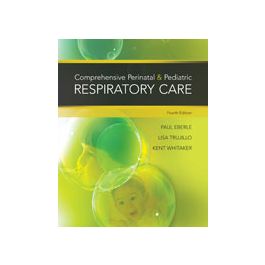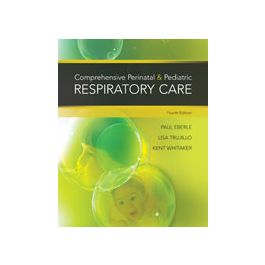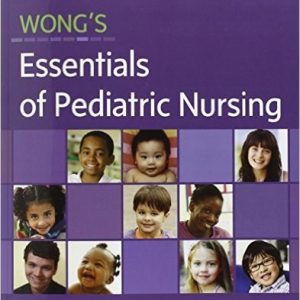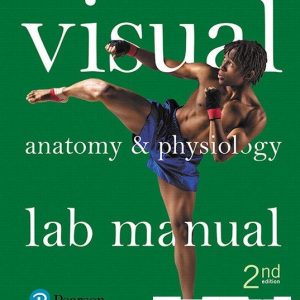This is completed downloadable of Test Bank for Comprehensive Perinatal and Pediatric Respiratory Care 4th Edition by Whitaker

Product Details:
- ISBN-10 : 1439059438
- ISBN-13 : 978-1439059432
- Author: Kent Whitaker
Learn the latest in respiratory care for newborns and children from COMPREHENSIVE PERINATAL AND PEDIATRIC RESPIRATORY CARE, 4E. This newly updated book is clear, consistent, and easy for you to follow. Comprehensive coverage of fetal development of the cardiopulmonary system, is followed by respiratory care of neonatal and pediatric patients, and progresses into causes and care of respiratory illnesses. It provides discussion of the ventilation and oxygenation needs of neonatal and pediatric patients including information on both conventional and special techniques. Topics unique to this book, such as care of parents and home care, are discussed in detail. COMPREHENSIVE PERINATAL AND PEDIATRIC RESPIRATORY CARE, 4E provides you with the theory and clinical expertise necessary to embark on your career and meet the challenges presented in a rapidly changing health care environment.
Table of Content:
- Unit 1: The Neonatal Patient
- Chapter 1: Embryologic Development of the Cardiopulmonary System
- Introduction
- Brief Overview of Embryologic Development of the Fetus
- Development and Function of Intrauterine Structures
- Development of the Pulmonary System
- Surface Forces and the Role of Surfactant
- Fetal Lung Fluid
- Development of the Cardiovascular System
- Fetal Circulation
- The Development of Baroreceptors and Chemoreceptors
- Summary
- Posttest
- References
- Bibliography and Suggested Readings
- Chapter 2: Assessment of Fetal Growth and Development
- Introduction
- Modalities to Assess Fetal Status
- Estimating the Delivery Date
- Biophysical Tests of Fetal Well-Being
- Factors Identifying a High-Risk Pregnancy
- Summary
- Posttest
- References
- Bibliography and Suggested Readings
- Chapter 3: Labor, Delivery, and Physiologic Changes after Birth
- Introduction
- Pregnancy
- Parturition
- Stages of Normal Labor and Delivery
- Abnormal Labor and Delivery
- Adaptation to Extrauterine Life
- Summary
- Posttest
- References
- Bibliography and Suggested Readings
- Chapter 4: Techniques of Resuscitation and Stabilization of the Neonatal Patient
- Introduction
- When to Resuscitate
- Preparation for Resuscitation
- Standard Precautions
- Determine If the Neonate Requires Resuscitation
- Steps in Neonatal Resuscitation
- Apgar Score
- Management of Serum Glucose
- Obtaining Umbilical Vessel Blood Samples during Resuscitation
- Summary
- Posttest
- References
- Bibliography and Suggested Readings
- Chapter 5: Assessment of the Neonatal and Infant Patient
- Introduction
- Anatomic and Physiologic Considerations
- Physical Assessment of the Neonate
- Purpose of the Physical Examination of the Neonate
- Neonatal Pulmonary Function Testing (PFT)
- Summary
- Posttest
- References
- Bibliography and Suggested Readings
- Chapter 6: Continuing Care of the Neonate
- Introduction
- Thermoregulation
- The Physiology of Heat Loss
- Cold Stress: Response and Complications
- Response to Hyperthermia
- Thermoregulation in the Delivery Room
- Prevention of Convective and Conductive Loss
- Thermoregulation in the Nursery
- Incubators versus Open Warmers
- Developmental Needs of the High-Risk Ne
- Skin Care of the Premature Neonate
- Fluid and Electrolyte Balance
- Neonatal Jaundice
- Necrotizing Enterocolitis (NEC)
- Summary
- Posttest
- References
- Bibliography and Suggested Readings
- Chapter 7: Perinatal Lung Disease and Other Problems of Prematurity
- Introduction
- Consequences of Premature Birth
- Processes of Intrauterine Origin
- Barotraumatic Diseases: Air Leak Syndromes
- Other Respiratory Diseases of the Neonate
- Summary
- Posttest
- References
- Bibliography and Suggested Readings
- Chapter 8: Causes of Persistent Perinatal Illness
- Introduction
- Infections
- Bacterial Infections
- Viral Infections
- Protozoal and Fungal Infections
- Diagnosis and Treatment of Infection
- Prevention of Infection
- Fetal Immunities
- Congenital Anomalies
- Respiratory Care of the Patient with Cardiac Defects
- Summary
- Posttest
- References
- Bibliography and Suggested Readings
- Unit 2: The Pediatric Patient
- Chapter 9: Techniques of Pediatric Resuscitation and Stabilization
- Introduction
- Pediatric Advanced Life Support
- Trauma Care
- Shock
- Near Drowning
- Pulmonary Emergencies
- Burns
- Spinal Cord Injuries
- Head Injury
- Sudden Infant Death Syndrome
- Poisoning
- Anaphylaxis
- Summary
- Posttest
- References
- Bibliography and Suggested Readings
- Chapter 10: Assessment of the Pediatric Patient
- Introduction
- Anatomic and Physiologic Differences
- Physical Assessment of the Pediatric Patient
- Well Child Head-to-Toe Examination
- Anticipatory Guidance
- Pediatric Pulmonary Function Testing (PFT)
- Arterial Blood Gas Analysis
- Summary
- Posttest
- References
- Bibliography and Suggested Readings
- Chapter 11: Continuing Care of the Pediatric Patient
- Introduction
- Growth and Development
- Behavioral Development
- Immunization
- Behavioral Problems
- Eating Disorders
- Pediatric Fever
- Acute Otitis Media
- Thermoregulation
- Summary
- Posttest
- References
- Bibliography and Suggested Readings
- Chapter 12: Pediatric Diseases Requiring Respiratory Care
- Introduction
- Ventilatory Diseases
- Neuromuscular Disorders
- Infectious Lung Diseases
- Summary
- Posttest
- References
- Bibliography and Suggested Readings
- Unit 3: General Concepts of Clinical Medicine
- Chapter 13: Respiratory Care Procedures
- Introduction
- Oxygen Therapy
- Airway Clearance
- Suctioning
- Aerosol Therapy
- Pre- and Postassessment of Patient
- Summary
- Posttest
- References
- Bibliography and Suggested Readings
- Chapter 14: Pharmacology
- Introduction
- Placental Drug Transfer
- Neonatal Pharmacokinetics
- Medications
- Effects of Maternal Drug Abuse on the Fetus
- Summary
- Posttest
- References
- Bibliography and Suggested Readings
- Chapter 15: Assessment of Oxygenation and Ventilation
- Introduction
- Respiratory Rate
- Color
- Work of Breathing/Dyspnea
- Breath Sounds
- Tactile Fremitis
- Arterial Blood Gas Analysis
- Arterial Blood Gas Assessment
- Oxygen Content
- Respiratory Disorders
- Metabolic Disorders
- Transcutaneous Monitoring
- Pulse Oximetry
- Summary
- Posttest
- References
- Bibliography and Suggested Readings
- Chapter 16: Interpretation of Chest X-Rays
- Introduction
- Basic Concepts
- Method of Interpretation – A Systemic Approach
- Radiographic Findings in Neonatal Lung Pathology
- Radiographic Findings in Pediatric Lung Pathology
- Summary
- Posttest
- References
- Bibliography and Suggested Readings
- Unit 4: Management of Ventilation and Oxygenation
- Chapter 17: Concepts of Mechanical Ventilation
- Introduction
- Goals of Mechanical Ventilation
- Definitions
- Clinical Applications
- Pressure-Volume Relationships (Compliance)
- Pressure-Flow Relationships (Resistance)
- Time Constants (Kt)
- Summary
- Posttest
- References
- Bibliography and Suggested Readings
- Chapter 18: Management of the Patient-Ventilator System
- Introduction
- Indications for Ventilatory Support of the Neonate and Child
- Modes of Mechanical Ventilation
- Partial Ventilatory Support (PVS)
- Full Ventilatory Support
- Setting Initial Ventilator Parameters
- Volume versus Pressure-Controlled Ventilation
- Changing Ventilator Parameters in Volume and Pressure Ventilation
- Hazards of Mechanical Ventilation and How to Avoid Them
- Weaning and Extubation
- Neonatal Patient
- Pediatric Patient
- Summary
- Posttest
- References
- Bibliography and Suggested Readings
- Chapter 19: Common Infant and Pediatric Ventilators
- Introduction
- Bio-Med Crossvent 2i+
- CareFusion 3100A
- CareFusion AVEA Ventilator
- Drager Babylog 8000 Plus
- Drager Evita XL
- Hamilton Galileo
- Maquet Servo-i
- Newport HT70 Plus
- Puritan Bennett 840
- Sechrist Millennium
- Summary
- Posttest
- References
- Bibliography and Suggested Readings
- Chapter 20: Special Procedures and Nonconventional Ventilatory Techniques
- Introduction
- Surfactant Replacement Therapy
- High-Frequency Ventilation (HFV)
- Specialty Medical Gases
- Extracorporeal Life Support (ECLS)
- Partial Liquid Ventilation
- Negative Pressure Ventilation (NPV)
- Summary
- Posttest
- References
- Bibliography and Suggested Readings
- Unit 5: Advanced and Specialty Care
- Chapter 21: Perinatal Transport
- Introduction
- History
- Types of Transport
- Personnel
- Necessary Equipment
- Infant Preparation and Transportation
- Transportation Procedures
- Special Needs
- Summary
- Posttest
- References
- Bibliography and Suggested Readings
- Chapter 22: Home Care
- Introduction
- History of Modern Home Care
- Home Care Models
- Patient Selection
- Home Care of the Ventilator-Dependent Child
- Home Aerosol Therapy
- Chest Physiotherapy and Suctioning
- Apnea Monitoring
- Oxygen Therapy
- Discharge Planning
- Discharge
- The Effects of Home Care on the Family
- Failure of Home Care
- Summary
- Posttest
- References
- Bibliography and Suggested Readings
- Chapter 23: Care of the Parents
- Introduction
- Bonding
- Causes of Parental Stress
- Implications for the Respiratory Therapist
- Understanding Grief
- Summary
- Posttest
- References
- Bibliography and Suggested Readings
- Appendix A: Laboratory and Clinical Proficiency Check-Offs
- Appendix B: Strategies to Prepare for the Neonatal/Pediatric Speciality Examination
- Appendix C: Selected Average Laboratory Values
- Appendix D: Charts of Average Vital Signs
- Appendix E
- Appendix F
- Appendix G
- Appendix H
- Appendix I: Physical Growth Chart
- Glossary
- Index





